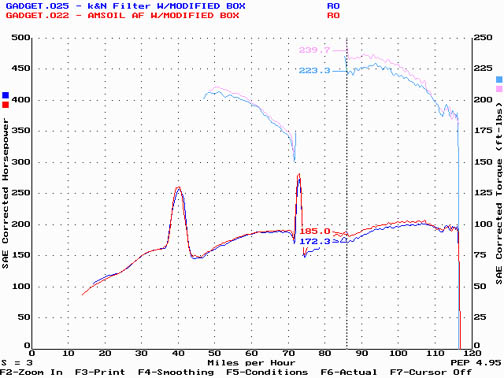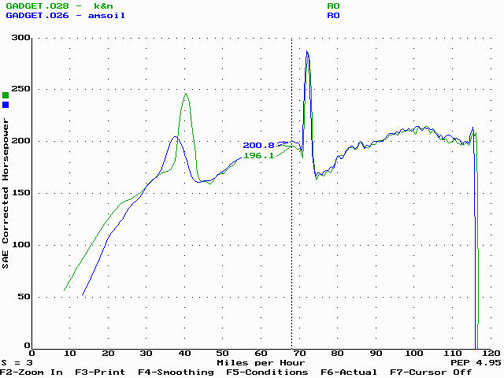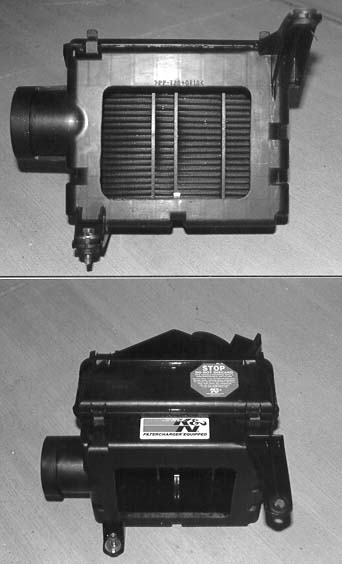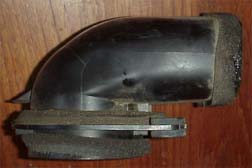Air
Induction

Index:

Introduction:
There are many products on the
market that "claim" an increase in
performance "up to 15 bolt on horse power."
Well that is saying from 0 to 15 HP increase, or
maybe just zero, or worst, less then zero. I tested
several different configurations in my air induction
system. Some of the results were expected and some
were not. I have laid out my tests and the results so
read on.
These tests were conducted with
my 96 4Runner equipped with, TRD Supercharger with
the FMU, Edlebrock Headers, Borla Cat-back exhaust, Kenne-Bell
Boost-A-Pump, and the stock MAF unless other
wise indicated.
I do not recommend
that you make any mods to your air induction system
if you have a supercharger unless you increase fuel
delivery. This includes removing the
elbow. Some others have made these mods without
increasing their fuel delivery and lost power. I
believe this is due to the lean fuel mixture with the
stock fuel system and these mods just compound the
problem. If you have a supercharger at a minimum you
really need to install a BAP and a properly
functioning FMU. See my fuel delivery page for more information.
Back to page index

K&N and
AMSOIL drop in air filter:
One of the first modifications
I did was to install the free K&N air filter that
came with my Borla Cat-Back Exhaust system. I ordered
it from Performance Products and they included a drop
in K&N air filter. I did not notice any increase
in performance with the K&N filter and later
dumped it when I found that it does not do a very
good job of filtering air.

I had seen some other test
results showing that the oiled foam filter from
AMSOIL worked better then K&N. These tests also
showed that the K&N let too much dirt through.
That kind of makes sense. If you hold the K&N up
to a light you can see little holes in it, and even
K&N says the dirtier it gets the better it
filters. I guess the added dirt plugs all the little
holes.
I got my AMSOIL filter (TS-115)
and found it to be very thick and it completely
blocks all the light. I thought that maybe in some
applications the AMSOIL might beat K&N on HP, but
this may not be one of them.

I ran a comparison of the
K&N and the AMSOIL on the dyno and was surprised
to find that the AMSOIL beat the K&N. I did not
expect it. I have no doubt that the AMSOIL was a
better air filter for filtering out dirt, but I was
surprised it also made more power.
This test used the standard
configuration and the VPC with 270 cc injectors.

Here is another
dyno run I did with the Split Second with the 3 inch
MAF and 305 cc injectors. As you can see the AMSOIL
air filter made more power then the drop in K&N
again. That is two different comparison tests on two
different dyno dates with different configurations.
So for those of you that have your minds made up and
do not want to be confused with the facts just keep
your heads in the sand and ignore the hard data.
You will notice
the difference in the first gear run. That was caused
by excessive wheel spin and the tires breaking
traction again during the shift with a loud CHIRP. It
was a real attention getter around the dyno shop.
If you want to get
an AMSOIL air filter for your truck and have a 96+ 3.4L 4Runner or
Tacoma you want the TS-115 if you have a 2.7 you want the TS-117. After writing down the numbers go to my AMSOIL web
page. I have the links you need to order the filters and what
every else you want on line.
Back to page index

Modified Air Box:

When I changed the air filter I
took a close look at the air box and tried to figure
a way to modify it to increase airflow to the engine
without increasing the induction noise.
I got to work with my trusty
Dremel tool and cut open the front of the air box. I
left a good size lip around the edge of the opening
to act as a sound baffle to reflect the inductive
pulse back down the air tube into the engine and to
maintain structural integrity of the box. My work
paid off and I noticed an increase in performance
without an increase in induction noise.
Franken Taco has taken my open
front idea and improved on it. He cut a whole in the
front and then installed a boat deck plate in the
opening. The deck plate has a center plate that can
be removed for normal operations and then closed for
water crossings. This seems to have become the
standard airbox mod for the "off roaders." Check
out his web page
for
more information on this good improvement on my idea.
Back to page index

K&N Fuel
Injection Performance Kit:

K&N released the Fuel
Injection Performance Kit (FIPK) for the 3.4 and I
ordered one from Performance Products. By this time I
had the supercharger installed. I was surprised at
the substantial increase in induction noise and I did
not notice any increase in power.
I was told by the people at TRD that they have tested the FIPK and they
saw a reduction in power. I later ran my own dyno
test and found this to in fact be true. You do have
to admit, it does look faster, right??
The FIPK also cause damage to
my 4Runner. The overall design of it does not allow
enough give to allow for the movement of the engine
in its mounts. The FIPK uses the same mounting points
as the stock air box and I found that the FIPK had
pulled the mounting bolt right through the fender
mounting point, ripping and tearing the sheet metal.
I do not recommend anyone install this set up in his
or her vehicle. I had a reduction in power with my
supercharger, and damage to my 4Runner as a result of
installing the FIPK. I reinstalled my modified air
box.
Back to page index

Remove the Elbow:
I was contacted by TRD and we discussed the dyno testing that
I was doing and my air box modifications. I was told
about removing the "elbow" from the air box
and that they saw and increase in performance in
doing so. They asked me to test it on my next set of
dyno runs.

The elbow is mounted in the
inner fender wall and the pipe from the air box slips
into it. On the other side of the fender wall the
elbow makes a sharp right turn and joins another tube
that continues backward and upward inside the fender.
The sharp turn is very restrictive.
It is easy to remove. Remove
the air box and unbolt two bolts that hold the elbow
to the fender. Then wiggle it out.
I did get a suggestion from one
of the visitor to my site. He recommended removing
the elbow and then cutting off the part that is
inside of the fender and then reinstalling the
remaining part to maintain the seal with the fender
wall.
Here is a link to a web page that a friend put together that lays out
the elbow removal really well.
Back to page index

The Test Results:
During this set of dyno testing
I compared all different configurations with the air
box. I seal the opening I cut in the front of the air
box and ran it. I then removed the "elbow"
and ran it. Then I removed the temporary cover
sealing the hole I cut in the front of the box and
ran it. I then remove the air box and tested the
FIPK.

Configuration and
Results: *Note- runs with the stock
air-box used a replacement drop in K&N filter and
the stock AFM*
Configuration
|
1st
|
2nd
|
3rd
|
| Run 9 Stock Box No
Front |
173.3 HP |
205.5 HP |
210.8 HP |
| Run 8 Stock Box No
Elbow |
170.7 HP |
205.1 HP |
210.8 HP |
| Run 7 Stock Box |
168.8 HP |
199.5 HP |
201.8 HP |

My results showed that opening
the front of the air box made the most power,
followed extremely close by just removing the elbow.
These two configurations and the completely stock box
beat the FIPK.
Configuration
& Results:*Note- runs with the stock
air-box used a replacement drop in K&N filter and
the stock AFM*
Configuration
|
1st
|
2nd
|
3rd
|
| Run 9 Stock Box No
Front |
173.3 HP |
205.5 HP |
208.6 HP |
| Run 7 Stock Box |
168.8 HP |
199.5 HP |
202.2 HP |
| Run 6 K&N FIPK |
169.4 HP |
202.3 HP |
199.0 HP |
This is the test
that is sure to get some folks upset. Performance
products is selling the K&N FIPK for $219. The
K&N FIPK beats the stock box by .6 HP in 1st, 2.8
in 2nd, but looses to the stock box by 3.2 in 3rd for
an average loss of .06 HP.
Now if you just
cut open the front of the box you get 6.4 HP over the
stock box for free or 9.6 over the K&N FIPK.
Remember from the previous chart you will get
basically the same results by removing the elbow as
cutting open the box. I think this might be the way
to go so you can pop it back in if you decide to go
swimming.
Back to page index

Other Ideas:
There are a couple
of people that have taken their induction systems a
little further then I have.

Ron has
installed custom scoops that fit below the head
lights.


Travis has installed custom
fiberglass hood and front fenders. He is working on
custom fiberglass rear bed sides. Email Travis for more information.
Back to page index

Final
Recommendations:
My final
recommendation for the air filter and air box is to
use an AMSOIL filter and remove the elbow from the
fender wall. You can always pop the elbow back in
when needed. The next step is to remove or replace
the air flow meter. I cover that in the fuel delivery
section.
Back to page index

|